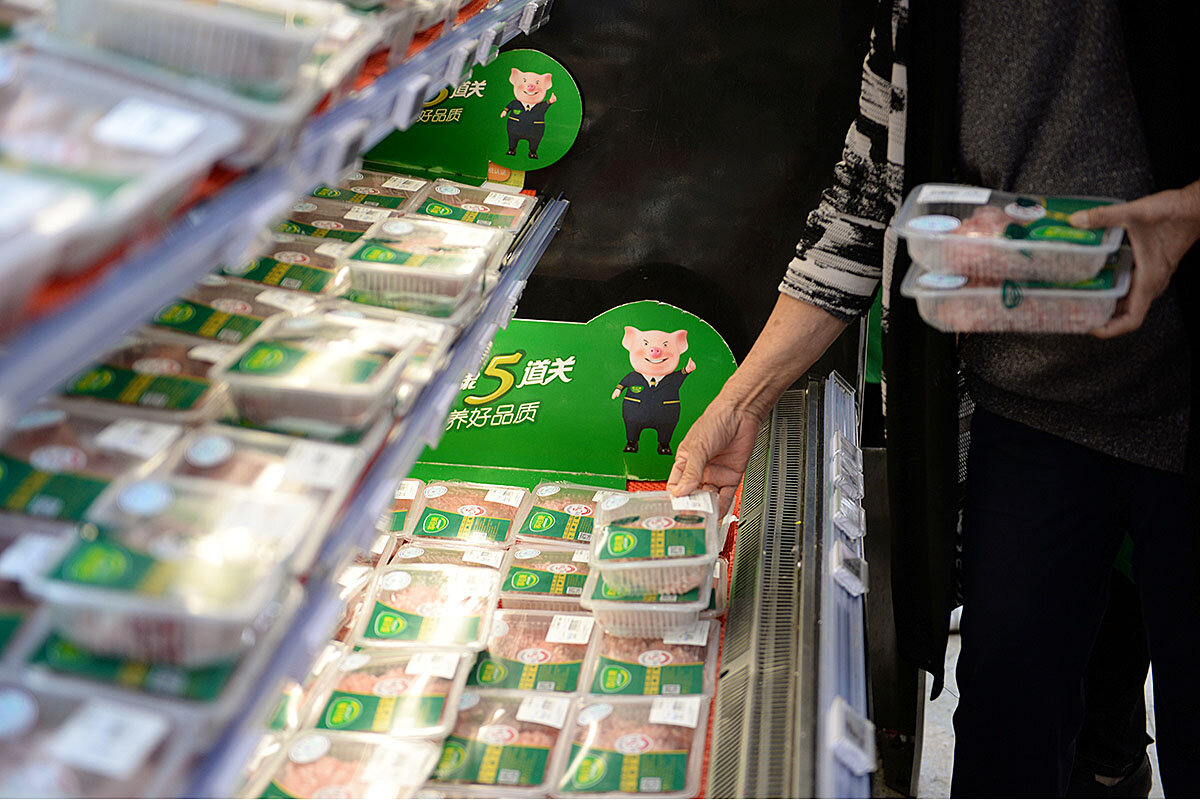China’s great pork shortage: Why it could cost Beijing
Loading...
| SEATTLE
As China’s Communist Party leaders confront challenges ranging from Hong Kong protests to the trade war, a more alimental problem has Beijing nervous: a paucity of pigs.
China faces a huge shortage of pork – by far the country’s favorite meat – after losing about half of its hog herd to African swine fever over the past 15 months. China’s pork production has plummeted an estimated 45%, while the price of pork soared 101% in October compared with a year earlier, according to INTL FCStone, a U.S. financial services group, and Chinese government statistics.
Discontent among Chinese consumers, especially the poor and middle class, is politically risky for the party, which has based its mandate on steadily raising living standards – a more difficult act in recent years, as the country’s economy slows. Now, the party’s ability to “bring home the bacon” is, literally, in doubt.
Why We Wrote This
Cuisine is a window onto a culture – and politics. Decimated hog herds may affect Chinese views on the government’s ability to provide for its people.
“If the regime can’t supply pork at reasonable prices, it’s a big knock to their legitimacy,” says William C. McCahill Jr., senior resident fellow at the National Bureau of Asian Research in Seattle. “The whole notion of … food security is a huge issue for the regime,” says Mr. McCahill, an expert on Chinese politics and former U.S. diplomat in Asia.
But by highlighting China’s potential for food vulnerability and dependence on global markets, the pork predicament also creates new opportunities for boosting trade – as well as potential health and environmental benefits.
“Symbol of the good life”
It is hard to overstate the appetite for pork among China’s 1.4 billion people, who last year consumed almost half of the total global supply of the meat. Pork has accounted for more than 60% of Chinese meat consumption, with citizens eating an average of about 88 pounds each per year.
“Pork is the most important meat for most residents in China,” said Vice Premier Hu Chunhua in an August speech. “The guarantee of supply is related to people’s livelihood and matters to the overall situation,” Mr. Hu said, calling pork production a “political task.” He warned that severe shortages could impact major holidays into 2020, the party’s target year for China to become a “well-off society.”
From Cantonese barbecue in the south to boiled dumplings in the north, pork’s almost mythical place in China’s cuisine and culture explains why no other meat can replace it. Indeed, in Chinese the word “meat” refers to pork. The Chinese character for “family” and “home” depicts a pig under the roof of a house. Pork dishes are central to festivals, weddings, and rituals honoring ancestors, where huge slabs of the meat are divided among descendants, says James Watson, an anthropologist and Harvard professor emeritus of Chinese society.
During the economic turmoil of the Maoist years, pork was a once-a-year treat for millions of poor Chinese peasants and was rationed in urban areas. But since the market reforms of the 1980s, the gradual emergence of pork as a daily staple has become a comforting sign of well-being. Pork in modern China is “the symbol of the good life” and “a reward for hard work,” says Professor Watson.
But now, skyrocketing prices are putting pork out of reach for many shoppers. Even the wealthy may go without, as restaurant waiters tell diners pork dishes are sold out.
Beijing has responded to the crisis with extraordinary measures – such as tapping into the country’s strategic reserve of frozen pork. “For the Chinese, pork does have national security implications,” says Mr. McCahill, “so they have been releasing stocks from the frozen pork supply.” The government put 30,000 metric tons of pork reserves on the market in September to try to curb rising prices, according to state media reports.
In addition, some localities have capped pork prices and – for the first time since the 1980s – issued ration coupons for the meat. But such steps have proved ineffective, while reminding those who lived through the Maoist rationing of “some very bad old days,” says Mr. McCahill.
To prevent public alarm, Beijing has limited state-run media reporting on the pork shortfall and made optimistic forecasts about rebuilding the herds, says Arlan Suderman, chief commodities economist at INTL FCStone. “China is trying to keep people calm and avoid panic,” he says. But he predicts the current shortage and high prices will persist at similar levels next year. “We see absolutely no indication they’re going to be able to rebuild production in 2020,” he says.
Trade implications
The pig plight is increasing Beijing’s dependence on foreign pork and other meats. Although China has been highly self-sufficient in pork, producing 95% of its consumption in 2018, it was still the third-largest pork importing nation, buying more than $2 billion worth of pork.
This can require mending diplomatic ties. On Nov. 5, China lifted its ban on imports of Canadian pork. It has also increased pork purchases from Europe, Brazil, and the United States.
The hog crunch is one factor that may nudge China toward a trade deal with the United States that would eventually involve lifting tariffs and increasing farm trade, analysts say. Chinese buyers willing to pay more for pork than U.S. consumers “will bid that pork away,” causing possible shortages as Americans shop for their holiday hams, Mr. Suderman says. U.S. pork prices have already started to rise – unusual for fall when supply is greater – as China’s imports grow, Reuters reported Tuesday.
Even then, China’s pork consumption is so vast that if it imports all the world’s tradable pork and uses up its own frozen reserves, a shortage would still exist, according to research by Jack Caporal, an associate fellow at the Center for Strategic and International Studies.
Meanwhile, swine fever rages on, killing hogs faster than they can be replaced. “Globally we expect about a quarter of the world’s pig population to be lost,” says Dr. Mark Schipp, president of the World Organisation for Animal Health, in remarks emailed by his office. He called the epidemic “arguably the biggest threat to any commercial livestock species we’ve seen, certainly within a generation.”
A possible silver lining? China is moving to discourage pork consumption, citing health benefits from alternative proteins. “It’s better to eat less pork,” read the headline of a front-page article in September in the party-affiliated newspaper Life Times. If the Chinese eat less pork, the environment would benefit too – as smaller pig herds generate less greenhouse gas, and fewer acres of rainforests are cleared to grow soybeans for pig fodder. Fitting changes, perhaps, for the year of the pig in the Chinese zodiac.







